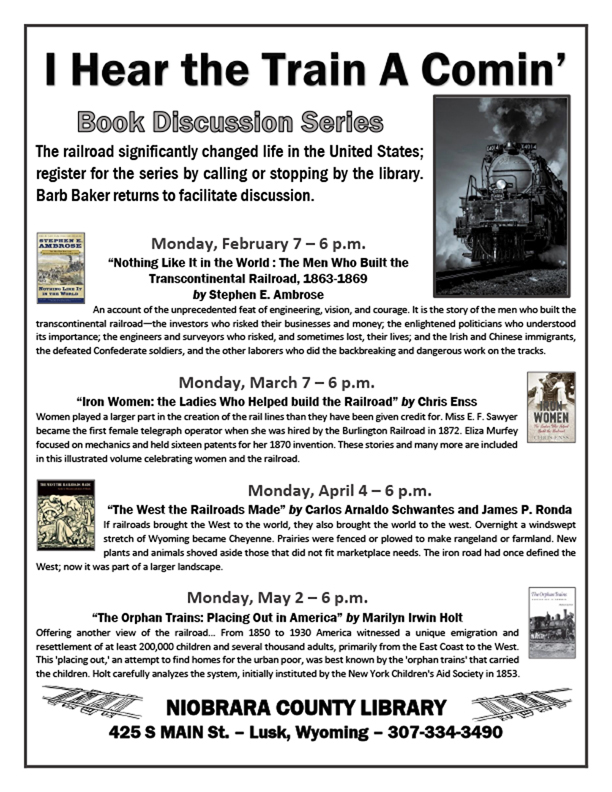Register for the Winter Book Discussion Series
- Date(s): Monday, December 20th 2021 - Friday, January 7th 2022
- Time: 6 p.m. - First Monday of the Month
- Location: Niobrara County Library
The railroad significantly changed life in the United States; register for the series by calling or stopping by the library. Barb Baker returns to facilitate discussion.
Monday, February 7 – 6 p.m. — “Nothing Like It in the World : The Men Who Built the Transcontinental Railroad, 1863-1869 by Stephen E. Ambrose
An account of the unprecedented feat of engineering, vision, and courage. It is the story of the men who built the transcontinental railroad—the investors who risked their businesses and money; the enlightened politicians who understood its importance; the engineers and surveyors who risked, and sometimes lost, their lives; and the Irish and Chinese immigrants, the defeated Confederate soldiers, and the other laborers who did the backbreaking and dangerous work on the tracks.
Monday, March 7 – 6 p.m. — “Iron Women: the Ladies Who Helped build the Railroad” by Chris Enss
Women played a larger part in the creation of the rail lines than they have been given credit for. Miss E. F. Sawyer became the first female telegraph operator when she was hired by the Burlington Railroad in 1872. Eliza Murfey focused on mechanics and held sixteen patents for her 1870 invention. These stories and many more are included in this illustrated volume celebrating women and the railroad.
Monday, April 4 – 6 p.m. — “The West the Railroads Made” by Carlos Arnaldo Schwantes and James P. Ronda
If railroads brought the West to the world, they also brought the world to the west. Overnight a windswept stretch of Wyoming became Cheyenne. Prairies were fenced or plowed to make rangeland or farmland. New plants and animals shoved aside those that did not fit marketplace needs. The iron road had once defined the West; now it was part of a larger landscape.
Monday, May 2 – 6 p.m. — “The Orphan Trains: Placing Out in America” by Marilyn Irwin Holt
Offering another view of the railroad… From 1850 to 1930 America witnessed a unique emigration and resettlement of at least 200,000 children and several thousand adults, primarily from the East Coast to the West. This ‘placing out,’ an attempt to find homes for the urban poor, was best known by the ‘orphan trains’ that carried the children. Holt carefully analyzes the system, initially instituted by the New York Children’s Aid Society in 1853.

